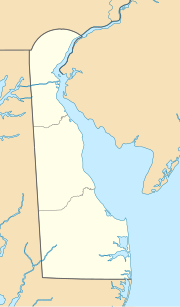Delaware National Estuarine Research Reserve
| Delaware National Estuarine Research Reserve | |
|---|---|
IUCN category IV (habitat/species management area)[1] | |
| Location | Kent County, Delaware, Delaware, United States |
| Coordinates | 39°05′33″N 75°26′44″W / 39.092466°N 75.445433°W |
| Established | 1937 |
| Visitors | Open daily |
| Website | Delaware National Estuarine Research Reserve |
The Delaware National Estuarine Research Reserve consists of two unique components, one on
The reserve monitors long-term changes in weather and aquatic conditions in the
St. Jones Center for Estuarine Studies
The St. Jones Center for Estuarine Studies offers a wide variety of educational programs about the reserve for the general public, school groups, private and nonprofit organizations, educators and coastal decision makers. Coastal decision-maker workshops have included such topics as land-use planning and smart growth, energy resource conservation and development for the next decade and acoustical bay bottom mapping. Visitor can explore hands-on interactive activities and exhibits including fish tanks, a recycling center, restoration demonstration areas as well as a variety of programs and volunteer opportunities for the community, teachers, students, and families. The Center also supports ongoing research and monitoring, field studies, citizen monitoring programs, and training opportunities for coastal decision makers. [3]
References
- ^ "Delaware National Estuarine Research Reserve". Protected Planet. IUCN. Retrieved 1 May 2018.
- ^ "Delaware National Estuarine Research Reserve". National Estuarine Research Reserves. NOAA. Retrieved 1 May 2018.
- ^ "St. Jones Reserve". State of Delaware. Retrieved 1 May 2018.
External links
![]() This article incorporates
This article incorporates

